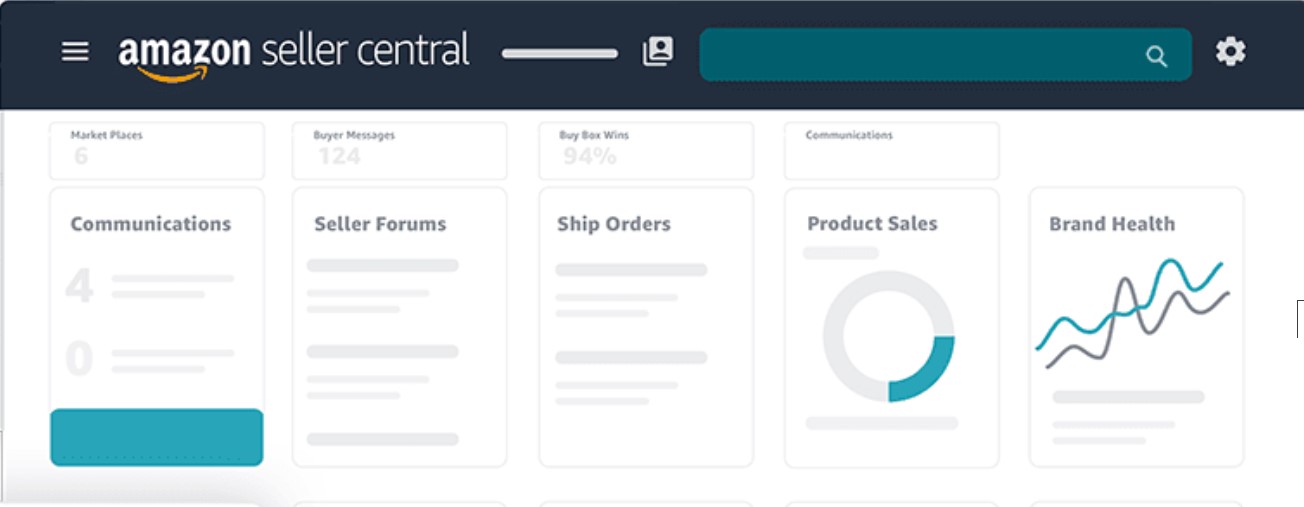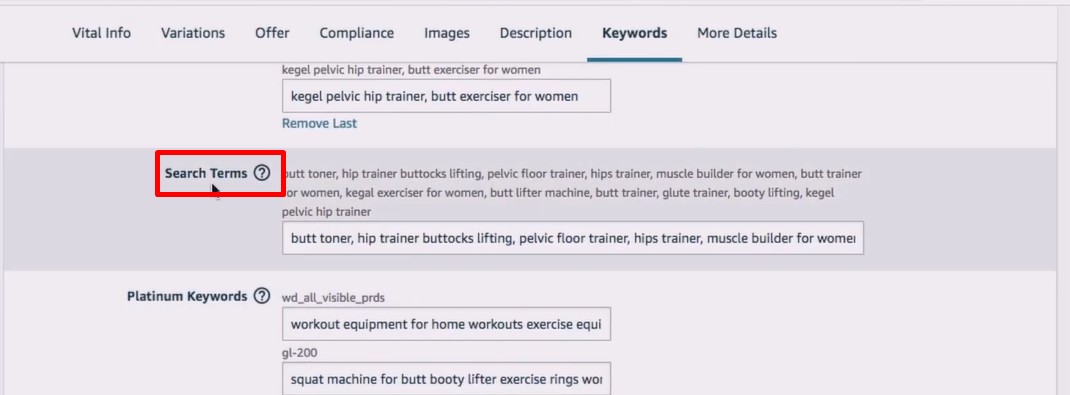Amazon, the e-commerce giant, is not only a platform for buying and selling products but also a colossal search engine. When customers are looking for products, they turn to Amazon’s search bar, and just like with Google or any other search engine, keywords, including Amazon backend keywords, are the key to discoverability. Amazon SEO (Search Engine Optimization) is crucial for any seller, as it directly impacts your product’s visibility and, ultimately your sales.
To master Amazon SEO, you need to understand not only the basics of optimizing your product listing but also the often-overlooked realm of backend keywords. These hidden gems play a vital role in helping your products stand out in the crowded Amazon marketplace.
Quick Guide:
- What Are Amazon Backend Keywords?
- The Role of Backend Keywords in Amazon SEO
- Why Are Amazon Backend Keywords Important?
- How to Add Backend Keywords to Amazon Listing
- How to Find the Right Amazon Backend Keywords for Your Listing
- Conclusion
What Are Amazon Backend Keywords?
Backend keywords, as the name suggests, are a set of keywords or search terms that are not visible to customers on your Amazon product listing. These keywords are entered into the backend of your product listing, and they serve a specific purpose – to help Amazon’s search algorithm understand the nature and relevance of your product. In essence, they are metadata that aid in product discoverability.
These keywords are a critical component of Amazon SEO because they allow you to provide additional context about your product, making it more likely to appear in relevant search results. When a customer searches for a product, Amazon’s search engine takes these backend keywords into account, alongside the frontend keywords (the ones that customers see), to determine which products to display in the search results.
Differentiating backend keywords from frontend keywords
It’s important to distinguish between backend and frontend keywords. Frontend keywords are the ones you visibly incorporate into your product title, bullet points, and product description. These are the keywords that potential customers see when they browse your product listing.
Backend keywords, on the other hand, are not visible to customers. They are for Amazon’s internal use, enabling the platform to categorize and index your product accurately. This hidden aspect of backend keywords makes them a powerful tool for influencing your product’s search performance.
While character count limits frontend keywords and must be thoughtfully integrated into your product listing’s content, backend keywords offer more flexibility. They can include synonyms, misspellings, and other relevant terms that might not fit naturally in your product description.
Highlighting the hidden potential of backend keywords
The true power of backend keywords lies in their hidden nature. Since customers cannot see them, backend keywords allow you to add an extra layer of relevance to your product listing. When used strategically, they can help your product rank higher in search results, increasing its chances of being discovered by potential buyers.
Think of backend keywords as your secret weapon in the battle for Amazon’s top search positions. They enable you to target a wider range of search queries, encompassing variations and alternative phrasings that customers might use when searching for a product like yours. By leveraging this hidden potential, you can tap into a broader audience and outperform competitors who might overlook the importance of backend keyword optimization.
The Role of Backend Keywords in Amazon SEO
The connection between keywords and search ranking
To truly grasp the role of backend keywords in Amazon SEO, it’s essential to understand the fundamental connection between keywords and search ranking. Amazon’s search algorithm relies on keywords to match customer search queries with relevant products. The more relevant and accurate the keywords, the higher the chances of your product appearing in top search results.
Backend keywords are an integral part of this process. When you include them in your product listing, you provide Amazon’s algorithm with essential information about your product. This, in turn, helps Amazon place your product in search results that closely match what you offer.
For example, if you’re selling organic cotton t-shirts, you might include backend keywords like “sustainable,” “eco-friendly,” and “comfortable fabric.” These terms signal to Amazon that your product aligns with these customer preferences, increasing the likelihood of your t-shirts being displayed to shoppers interested in those attributes.
How backend keywords influence product discoverability
Backend keywords significantly impact your product’s discoverability. When a potential customer searches Amazon, the platform scans through its vast database of product listings to identify the most relevant items. This process involves matching customer search queries to product keywords.
By optimizing your backend keywords with precision and relevance, you increase the chances of your product appearing in more search results. This extended reach exposes your product to a broader audience, increasing the likelihood of attracting potential buyers.
Consider this scenario: A customer searches for “organic baby clothes,” and your product listing includes the relevant backend keywords. Even if your product primarily appears under searches for “organic baby onesies,” your backend keywords ensure it shows up for the broader query, improving your chances of making a sale.
Why Are Amazon Backend Keywords Important?
Emphasizing the competitive nature of Amazon
Amazon is a fiercely competitive marketplace, and staying ahead of the competition is a constant challenge for sellers. To succeed on this platform, you must recognize that every advantage matters. This is where backend keywords come into play.
In a marketplace flooded with millions of products, ranking well in search results can make or break your business. Your competitors are likely optimizing their listings to the best of their abilities, and if you’re not doing the same, you risk being overshadowed by more savvy sellers. Backend keywords provide you with a competitive edge because they allow you to tap into a vast array of relevant search queries, increasing your visibility.
If you want to stand out and thrive on Amazon, you can’t afford to overlook the importance of backend keywords in your overall SEO strategy.
How frontend keywords alone fall short
While front-end keywords are crucial for attracting customers and making your product listings informative and compelling, relying solely on them falls short in the complex world of Amazon SEO.
Character limits often constrain frontend keywords and must be seamlessly integrated into your product listing’s content. This can sometimes limit your ability to target a wide range of search queries effectively. Additionally, front-end keywords are highly visible to customers, so you must balance the need for SEO with creating a user-friendly and engaging product page.
Backend keywords, on the other hand, provide a flexible and discreet solution. They allow you to include a broader set of keywords that might not fit naturally in your front-end content. By expanding your reach with these hidden keywords, you can capture the attention of customers who use various search terms to find products like yours.
How to Add Backend Keywords to Amazon Listing
Step-by-step guide to adding backend search terms on Amazon
Optimizing Amazon backend search terms is a relatively straightforward process, but it requires attention to detail. Here’s a step-by-step guide to adding backend keywords to your Amazon product listing:
- Log in to your Amazon Seller Central account: Your journey begins by logging into your Amazon Seller Central account, which serves as your control center for managing your listings and products.

- Access the ‘Manage Inventory’ page: Under the ‘Inventory’ drop-down menu, you’ll find the option to ‘Manage Inventory.’ Click on it to access the list of products you currently have listed on Amazon.

- Find the listing where you want to add backend keywords: Within the ‘Manage Inventory’ page, locate the specific product listing for which you wish to optimize your backend keywords. Once you’ve identified it, click on the ‘Edit’ button associated with that listing. You will be redirected to a new page dedicated to that particular product.
- Select the ‘Keywords’ tab: On the product editing page, navigate to the ‘Keywords’ tab. This is where you can input your carefully chosen backend keywords.

- Enter your backend keywords: In the ‘Search Terms’ field, input your selected backend keywords. Be sure to separate each keyword or keyphrase with commas for clarity. Make the most of your character limit by being concise and prioritizing the most relevant terms.

- Save your changes: After entering your backend keywords, click on the ‘Save and finish’ button to ensure that your keyword changes are saved and applied to your product listing.
The importance of following Amazon’s guidelines
It’s crucial to emphasize that Amazon has specific guidelines and rules for backend keywords. Failing to adhere to these Amazon backend search terms guidelines can result in your product listings being penalized or removed. To effectively use backend keywords, you should:
- Avoid Prohibited Content: Do not use offensive, misleading, or prohibited content in your backend keywords. This includes using competitor brand names or making false claims.
- Respect Character Limits: Stick to Amazon’s character limit for backend keywords. At the time of writing, Amazon allows up to 249 bytes of backend keyword text for most categories. This is subject to change, so always check for the most up-to-date information.
- No Repeated Words: Do not repeat any words that are already in your frontend content or title. Amazon automatically indexes those keywords.
- No Punctuation Marks: Avoid using punctuation marks or special characters in your backend keywords.
- Stay Relevant: Ensure your backend keywords are directly relevant to your product. Misleading or irrelevant keywords can harm your listing’s performance.
- Monitor Amazon’s Updates: Amazon’s rules and guidelines may change over time, so it’s essential to stay informed and adapt your backend keyword strategy accordingly.
Tips for optimizing backend keywords effectively
Here are some additional tips to optimize your backend keywords effectively:
- Keyword Research: Conduct thorough keyword research to identify the most relevant and high-traffic search terms in your niche.
- Prioritize Relevance: Focus on the most relevant keywords that accurately describe your product. Quality over quantity is key.
- Regular Updates: Keep your backend keywords up-to-date to reflect changes in market trends, customer behavior, and competitor strategies.
- Competitor Analysis: Analyze the backend keywords of successful competitors to gain insights into effective keyword usage.
- Use Tools: Consider using Amazon keyword research tools to identify valuable backend keywords and track your performance.
How to Find the Right Amazon Backend Keywords for Your Listing
Tools and methods for keyword research
Effective backend keyword optimization begins with thorough keyword research. Several tools and methods can help you identify the most suitable backend keywords for your Amazon listing:
- Amazon’s Search Bar: Start with Amazon’s search bar. Begin typing a word or phrase related to your product, and you’ll see auto-suggestions. These suggestions can provide insights into what customers are searching for.
- Keyword Research Tools: Utilize keyword research tools like SellerApp or MerchantWords. These tools can help you discover high-traffic keywords and variations specific to your niche.
- Amazon PPC Campaigns: Running Amazon Pay-Per-Click (PPC) campaigns can provide valuable data on which keywords generate clicks and sales. Use this information to refine your backend keyword strategy.
- Customer Reviews: Analyze the reviews of similar products to identify keywords that customers commonly use when describing or searching for products like yours.
- Competitor Keywords: Look at your competitors’ product listings to identify the keywords they are using in their backend. This can provide insights into what works in your niche.
Identifying relevant long-tail keywords
Long-tail keywords, which are more specific and extended search phrases, can be particularly effective in targeting a niche audience. To identify relevant long-tail backend keywords:
- Use Keyword Research Tools: Many keyword research tools can help you uncover long-tail keywords that customers frequently search for. These may have a lower search volume but can yield more targeted traffic.
- Answer Customer Questions: Think about the questions customers might have about your product and use these as long-tail keywords. For example, if you sell camping gear, “best lightweight camping tent for two” could be a valuable long-tail keyword.
- Incorporate Product Features: Highlight unique features of your product as long-tail keywords. If your product is a water-resistant Bluetooth speaker, “waterproof portable speaker” could be a relevant long-tail keyword.
Competitor analysis for keyword inspiration
Analyzing your competitors’ strategies can provide valuable insights and inspiration for your backend keywords:
- Identify Top Competitors: Start by identifying your top competitors in your niche. These are the sellers whose strategies you want to study.
- Analyze Their Listings: Carefully review their product listings, including their frontend and backend keywords. Look for patterns and common themes in their keyword usage.
- Assess Customer Reviews: Check the customer reviews of your competitors’ products. Pay attention to phrases and terms that customers commonly mention, as these could be effective backend keywords.
- Monitor Changes: Continuously monitor your competitors’ listings and updates. They might adjust their backend keywords in response to market changes or trends.
- Adapt, Don’t Copy: While competitor analysis is valuable, remember that it’s essential to create your unique backend keyword strategy. Adapt their successful techniques to your products rather than directly copying them.
Conclusion
In the ever-competitive world of Amazon, backend keywords serve as a potent tool for improving your product listings’ visibility and attracting the right customers. By conducting thorough keyword research, including relevant long-tail keywords, and drawing inspiration from competitor strategies, you can craft a powerful backend keyword strategy that sets you apart from the competition.
Remember, Amazon’s search landscape is dynamic, and customer preferences evolve. Therefore, it’s crucial to continually refine and update your backend keyword strategy to stay relevant and maximize your product’s discoverability. With dedication and a well-executed backend keyword plan, you can enhance your Amazon SEO, improve your search rankings, and ultimately drive more sales on the platform.




